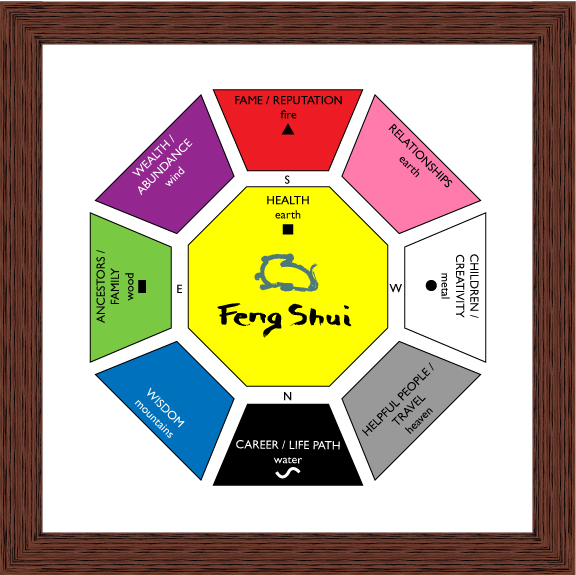Feng shui
|
This feng shui bagua map includes colours, elements, shapes, directions and a lucky rat in the centre. The diagram was created by Shandi Greve Penrod. |
Contents |
[edit] Introduction
Feng shui is an Ancient Chinese practice that is meant to respond to the interaction of humans and their environment. It is sometimes called the art of placement and is also referred to as Chinese geomancy.
The term “feng” means wind, while the term “shui” means water. These two elements are considered significant to positive human existence since they can represent movement and flow.
In its simplest form, feng shui is believed to use invisible energy forces from the universe to create balance and harness harmony - especially in architecture, interior design and other aspects of the built environment. It accomplishes this through the positioning of objects in a manner that taps into their positive energy known as chi or qi.
[edit] History
Evidence of feng shui appeared in China as early as 4000 BC. This method was based on the arrangement of structures - in particular those associated with spiritual activity - according to the alignment of elements associated with astronomy, water and other elements of nature. It was used to determine the placement and orientation of tombs, temples, homes and other buildings.
Another form of feng shui used an instrument known as shi to decide how and where to build structures. These devices were also called liuren astrolabes.
Bagua maps have also been used to determine the placement of buildings and within buildings. Mentioned in I Ching, these maps were early feng shui tools used to analyse energy and influence the placement of objects.
Feng shui continued to blossom in China over the centuries. It was adapted by various segments of the Chinese population and continued to be part of the culture until the People’s Republic of China came into power in 1949. At that point, it was considered counterproductive to government ideology and its practice was strongly discouraged in most places (other than Hong Kong and Taiwan).
The wave of disapproval continued in China during the country’s cultural revolution in the 1960s and 1970s. Interest in feng shui increased in the US during this period.
The practice has few followers in modern China, but its advocates have increased in different parts of the world. Its concepts have been embraced (and sometimes reinterpreted) by followers of religious beliefs that are associated with mysticism and other New Age sects.
[edit] Bagua maps
These maps continue to be used by feng shui practitioners, particularly in the area of interior design. They are used to decide which elements can be introduced into a space to produce the desired outcome.
There are eight elements that are commonly used on a bagua map. Five are considered most important. These include:
The maps are aligned with compass points (N, S, E, W) and divided into nine quadrants associated with an assigned element and a corresponding colour:
- Health - earth - yellow.
- Fame - fire - red.
- Wealth - wind -purple.
- Family - wood - green.
- Wisdom - mountains - blue.
- Career - water - black.
- Helpful people - grey - heaven.
- Children - metal - white.
- Love - earth - pink.
[edit] Legitimacy
Feng shui has been deemed a pseudoscience by some in the scientific community. This has not had an impact on its growing popularity, even in some parts of China.
The Bank of China Tower is a skyscraper in the Central and Western District of Hong Kong and is arguably the city’s most iconic building. It houses the headquarters of the Bank of China (Hong Kong) Limited. It was designed by the Pritzker Prize-winning architect I.M. Pei and L.C. Pei of I.M. Pei and Partners and was completed in 1989. It initially caused some controversy as the only major building in Hong Kong that did not consult feng shui practitioners.
[edit] Related articles on Designing Buildings Wiki
Featured articles and news
Latest Build UK Building Safety Regime explainer published
Key elements in one short, now updated document.
UKGBC launch the UK Climate Resilience Roadmap
First guidance of its kind on direct climate impacts for the built environment and how it can adapt.
CLC Health, Safety and Wellbeing Strategy 2025
Launched by the Minister for Industry to look at fatalities on site, improving mental health and other issues.
One of the most impressive Victorian architects. Book review.
Common Assessment Standard now with building safety
New CAS update now includes mandatory building safety questions.
RTPI leader to become new CIOB Chief Executive Officer
Dr Victoria Hills MRTPI, FICE to take over after Caroline Gumble’s departure.
Social and affordable housing, a long term plan for delivery
The “Delivering a Decade of Renewal for Social and Affordable Housing” strategy sets out future path.
A change to adoptive architecture
Effects of global weather warming on architectural detailing, material choice and human interaction.
The proposed publicly owned and backed subsidiary of Homes England, to facilitate new homes.
How big is the problem and what can we do to mitigate the effects?
Overheating guidance and tools for building designers
A number of cool guides to help with the heat.
The UK's Modern Industrial Strategy: A 10 year plan
Previous consultation criticism, current key elements and general support with some persisting reservations.
Building Safety Regulator reforms
New roles, new staff and a new fast track service pave the way for a single construction regulator.
Architectural Technologist CPDs and Communications
CIAT CPD… and how you can do it!
Cooling centres and cool spaces
Managing extreme heat in cities by directing the public to places for heat stress relief and water sources.
Winter gardens: A brief history and warm variations
Extending the season with glass in different forms and terms.
Restoring Great Yarmouth's Winter Gardens
Transforming one of the least sustainable constructions imaginable.























